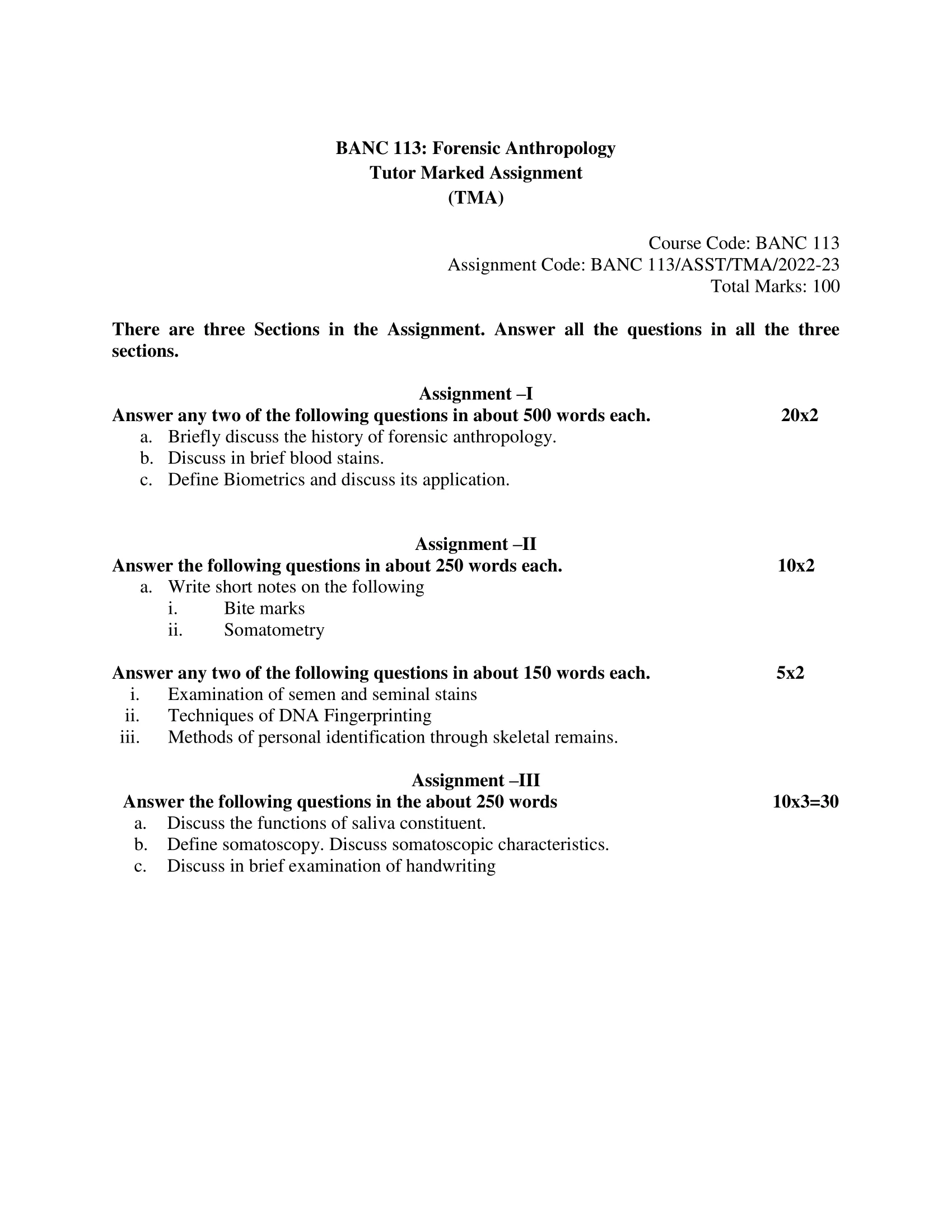
| Title | BANC-113: IGNOU BAG Solved Assignment 2022-2023 |
| University | IGNOU |
| Degree | Bachelor Degree Programme |
| Course Code | BANC-113 |
| Course Name | Forensic Anthropology |
| Programme Name | Bachelor of Arts (General) |
| Programme Code | BAG |
| Total Marks | 100 |
| Year | 2022-2023 |
| Language | English |
| Assignment Code | BANC 113/ASST/TMA/2022-23 |
| Last Date for Submission of Assignment: | For June Examination: 31st April For December Examination: 30th September |

Assignment –I
Answer any two of the following questions in about 500 words each. 20×2
a. Briefly discuss the history of forensic anthropology.
Ans: Forensic anthropology is the application of the principles of physical anthropology to the legal process. The history of forensic anthropology can be traced back to the late 19th and early 20th centuries, when anthropologists first began to apply their expertise to legal cases.
One of the earliest recorded uses of forensic anthropology was in the identification of soldiers killed in battle. In the American Civil War and later in World War I, anthropologists were called upon to help identify the remains of soldiers using their knowledge of human anatomy and skeletal biology. This work laid the foundation for the development of modern forensic anthropology.
In the early 20th century, the field of forensic anthropology continued to develop as anthropologists began to apply their expertise to criminal investigations. Anthropologists worked alongside police and other law enforcement agencies to assist in the identification of human remains, often in cases where the victim was unknown or the remains were too decomposed to be identified by other means.
The development of new technologies and techniques also played a role in the evolution of forensic anthropology. For example, the use of X-rays and other imaging technologies made it possible for anthropologists to study human bones in much greater detail, and the advent of DNA analysis revolutionized the field by providing a new means of identifying individuals.
One of the most significant events in the history of forensic anthropology was the establishment of the first forensic anthropology laboratory in the United States, which was created in the early 1940s. This laboratory was designed to provide forensic anthropology services to law enforcement agencies, and it quickly became a model for similar facilities around the world.
Today, forensic anthropology is a well-established discipline, with a large and growing body of research and a highly trained community of practitioners. The field continues to evolve and advance as new technologies and techniques become available, and it remains a critical tool in the investigation of crimes and the identification of victims.
Overall, the history of forensic anthropology reflects the evolution of a discipline that has grown from its roots in physical anthropology to become a key component of modern criminal investigations and legal processes.
b. Discuss in brief blood stains.
Ans: Blood stains are the marks or deposits left by blood on a surface or material. They can be caused by various sources, including cuts, scratches, wounds, or injuries. Blood stains can also result from natural events, such as menstruation or nosebleeds.
Blood stains are particularly important in forensic science, as they can provide important evidence in criminal investigations. Blood stains can reveal information about the source of the blood, such as the individual’s age, sex, or blood type. This information can be used to help identify the person responsible for a crime, or to exclude certain individuals as suspects.
The appearance of a blood stain can provide clues about the circumstances of the event that caused the stain. For example, the shape of a stain can indicate the direction of the flow of blood, while the size of a stain can provide information about the amount of blood involved. Additionally, the color of a blood stain can provide information about the age of the stain, as fresh blood is typically bright red, while older blood may appear brown or black.
The analysis of blood stains can be performed through various techniques, including visual examination, chemical analysis, and DNA analysis. Visual examination is the most common method of analyzing blood stains and involves the observation of the stain’s appearance, shape, size, and color. Chemical analysis involves the use of chemical reagents to detect the presence of blood or to identify the type of blood (e.g. human or animal). DNA analysis involves the extraction and analysis of DNA from the blood stain to identify the individual who left the blood.
One of the most important aspects of blood stain analysis is the proper collection and preservation of the stain. Blood stains should be collected as soon as possible after they are discovered, as exposure to light, heat, or other environmental factors can cause the stain to deteriorate or fade. Additionally, it is important to properly label and store the blood stain, as contamination or degradation can compromise the analysis results.
c. Define Biometrics and discuss its application.
Ans: Biometrics refers to the measurement and analysis of unique physical or behavioral characteristics, such as fingerprints, facial features, and iris patterns, for the purpose of verifying or identifying a person’s identity.
Biometrics has a wide range of applications, including:
- Security: Biometric authentication can be used to secure access to devices, buildings, and sensitive information.
- Law Enforcement: Biometric technology can help police identify criminal suspects, track known offenders, and monitor people on probation or parole.
- Border Control: Biometric data can be used to verify the identity of travelers and help prevent immigration fraud.
- Banking and Finance: Biometrics can be used for secure online transactions, reducing the risk of fraud and identity theft.
- Healthcare: Biometric data can help track patient information, improve medical record accuracy, and prevent medical identity theft.
In summary, biometrics plays a vital role in ensuring security and reducing fraud in various industries, by using unique physical or behavioral characteristics for identity verification and authentication.
Assignment –II
Answer the following questions in about 250 words each. 10×2
a. Write short notes on the following:
i. Bite marks
Ans: Bite marks are indentations or bruises left on a victim’s skin as a result of being bitten by another person or animal. Bite marks can be used as a form of forensic evidence in criminal investigations to identify the attacker, determine the force and direction of the bite, and link the attacker to the victim.
Bite marks can be found on a variety of surfaces, including skin, clothing, food, or objects. In forensic investigations, bite marks are usually compared to the dental records of suspected attackers to determine a match.
The analysis of bite marks is a complex process that involves taking photographs and casts of the bite mark, analyzing the patterns and shape of the teeth, and comparing these to the dental records of suspects.
ii. Somatometry
Ans: Somatometry, also known as somatometrics or somatotypology, is the study of human body measurements and proportions. It is used in various fields, including anthropology, physical anthropology, criminology, sports science, and human biology.
Somatometry involves the measurement of various body parts, such as height, weight, head size, limb length, and body shape, and the calculation of ratios between these measurements. This data is then used to classify individuals into somatotypes, or body types, based on their dominant body characteristics.
In criminology, somatometry can be used to identify suspects and track the growth and development of individuals over time. In sports science, somatometry is used to evaluate an athlete’s physical attributes and determine which physical characteristics are best suited for specific sports. In anthropology, somatometry is used to study human variation and evolution, as well as differences in body measurements between populations.
Overall, somatometry plays an important role in understanding human body size and shape and its relationship to various physical and biological processes.
Answer any two of the following questions in about 150 words each. 5×2
i. Examination of semen and seminal stains
Ans: Examination of semen and seminal stains is an important part of forensic science that involves the identification and analysis of bodily fluids to determine if they are of biological origin. Semen can be collected from a variety of surfaces such as clothing, bed sheets, and other items that may have come into contact with the fluid. The examination process involves the use of various techniques to determine if the stain is semen and, if so, to identify the source of the semen.
One of the most commonly used techniques for the examination of semen and seminal stains is microscopic examination. This involves the examination of the stain under a microscope to look for the presence of sperm cells. The presence of sperm cells is a strong indicator that the stain is semen. Another technique is chemical testing, which involves the use of reagents such as acid phosphatase to detect the presence of semen.
The examination of semen and seminal stains is important in criminal investigations because it can provide important evidence in cases of sexual assault and other crimes. The examination can also provide information about the identity of the individual who produced the semen, which can be used to link the individual to a crime scene. Overall, the examination of semen and seminal stains is a crucial aspect of forensic science and helps to provide important evidence in criminal investigations.
ii. Techniques of DNA Fingerprinting
Ans: DNA fingerprinting is a method used to identify and differentiate individuals based on their unique DNA profile. This technique is widely used in forensic science to solve crimes, establish biological relationships, and resolve disputes in fields such as immigration, paternity, and criminal investigations.
The two main techniques used in DNA fingerprinting are Restriction Fragment Length Polymorphism (RFLP) and Polymerase Chain Reaction (PCR). RFLP involves cutting the DNA sample into smaller fragments using restriction enzymes and then separating the fragments based on size using gel electrophoresis. The pattern of the fragments is unique for each individual and can be used to identify them.
PCR, on the other hand, is a process that amplifies specific regions of DNA. It involves adding short sequences of DNA called primers, which bind to specific regions of the DNA, and then using a DNA polymerase enzyme to synthesize many copies of the region of interest. The amplified DNA is then separated based on size and the pattern of the fragments is used to identify the individual.
DNA fingerprinting is a highly accurate and reliable method for identifying individuals. The technique has been widely used in criminal investigations and has been instrumental in solving many crimes. The results of DNA fingerprinting are admissible in court and can be used as evidence in legal proceedings.
iii. Methods of personal identification through skeletal remains.
Ans: Personal identification through skeletal remains can be a complex process, but several methods are commonly used to determine the identity of an individual. The goal of the identification process is to match the skeletal remains to a specific person through the use of unique, individual characteristics.
One of the most common methods is dental identification. This involves comparing dental records, including x-rays, to the teeth and jaws of the skeletal remains. Dental records are often unique to an individual and can provide a positive identification.
Another method is analysis of the skull and other bones to determine age, sex, ancestry, and stature of the individual. Anthropologists use morphological and morphometric techniques to study the bones and make a determination about the individual’s age, sex, ancestry, and height. These characteristics can be compared to missing person records to see if there is a match.
DNA analysis is also a valuable tool in personal identification through skeletal remains. DNA samples can be taken from the bones, and the profile can be compared to samples from family members or a reference sample from the missing person.
Finally, in some cases, other identification methods such as radiographic comparison or specific injury analysis can be used to identify an individual. These methods involve comparing X-rays, CT scans, or other medical records of the missing person to the remains.
Overall, personal identification through skeletal remains can be a challenging process, but a combination of these methods can provide a positive identification in many cases.
Assignment –III
Answer the following questions in the about 250 words 10×3=30
a. Discuss the functions of saliva constituent.
Ans: Saliva is a complex mixture of water, electrolytes, enzymes, and other organic and inorganic substances. It plays a crucial role in maintaining oral health and facilitating various functions in the oral cavity.
- Lubrication: Saliva helps to keep the mouth moist and prevents it from becoming dry, which can cause discomfort, bad breath, and other problems.
- Digestion: Saliva contains enzymes such as amylase that aid in the breakdown of carbohydrates and starches. This helps to start the digestive process in the mouth and makes it easier for the food to be swallowed and further digested in the stomach.
- Maintenance of oral health: Saliva contains antibodies and antimicrobial agents that help to prevent the growth of harmful bacteria and other microorganisms in the mouth. This helps to reduce the risk of tooth decay and other oral infections.
- Neutralization of acids: Saliva helps to neutralize the acids produced by bacteria in the mouth, which can help to prevent the demineralization of tooth enamel and reduce the risk of tooth decay.
- Taste perception: Saliva helps to dissolve and distribute food particles, allowing us to taste and savor the flavors of food.
- Buffer function: Saliva acts as a buffer, regulating the pH levels in the mouth and helping to prevent changes that can lead to tooth decay and other problems.
- Nutrient transport: Saliva helps to transport essential nutrients, such as calcium and phosphate, to the teeth and other oral tissues, promoting their growth and health.
- Speech: Saliva helps to lubricate the mouth and throat, making it easier to speak and preventing dryness and discomfort.
b. Define somatoscopy. Discuss somatoscopic characteristics.
Ans: Somatoscopy is a diagnostic technique that involves the examination of the physical appearance of a person in order to make inferences about their underlying health status or medical conditions. It is based on the concept that changes in the body can reveal underlying medical problems, and it can be used in combination with other diagnostic methods to reach a diagnosis.
Somatoscopic characteristics refer to the physical features and observations made during a somatoscopic examination. These can include:
- Build: The overall size and shape of a person’s body, including height, weight, and body composition.
- Posture: The way a person stands and sits, which can reveal information about underlying conditions such as musculoskeletal problems, spinal abnormalities, and neurological conditions.
- Skin: The appearance of the skin, including color, texture, and the presence of any rashes, bumps, or discoloration.
- Hair: The texture, color, and distribution of hair, which can provide clues about nutritional status and hormonal imbalances.
- Nails: The appearance of the nails, including shape, thickness, and color, can reveal information about nutritional status, cardiovascular health, and respiratory function.
- Face: The appearance of the face, including skin color and texture, eye movement, and facial expressions, can reveal information about underlying medical conditions such as anemia, neurological problems, and liver disease.
- Hands: The appearance of the hands, including color, temperature, and circulation, can reveal information about cardiovascular health and underlying medical conditions such as anemia and Raynaud’s disease.
c. Discuss in brief examination of handwriting.
Ans: Examination of handwriting, also known as graphology, is the study of the physical characteristics and patterns of a person’s handwriting in order to infer their personality traits, emotions, and mental state. This practice is based on the belief that a person’s writing style reflects their inner self and can reveal information about their character, motivations, and behavior.
During an examination of handwriting, a graphologist will consider several factors, including:
- Slant: The slant of the writing, whether it is straight, right, or left-slanting, can reveal information about a person’s emotional state and level of openness to others.
- Pressure: The pressure used when writing, whether it is light or heavy, can reflect a person’s emotional intensity, level of assertiveness, and mood.
- Size: The size of the writing, whether it is small or large, can reveal information about a person’s level of confidence, creativity, and attention to detail.
- Spacing: The spacing between letters and words, whether it is tight or loose, can reflect a person’s level of sociability, organization, and adaptability.
- Connectedness: The degree of connectedness between letters, whether the writing is legible and fluid, or disconnected and irregular, can reveal information about a person’s level of intelligence, introversion, and focus.
- Form: The form of the letters, whether they are round, angular, or irregular, can reveal information about a person’s level of creativity, social skills, and level of detail orientation.
How to Download BANC-113 Solved Assignment?
You can download it from the www.edukar.in, they have a big database for all the IGNOU solved assignments.
Is the BANC-113 Solved Assignment Free?
Yes this is absolutely free to download the solved assignment from www.edukar.in
What is the last submission date for BANC-113 Solved Assignment?
For June Examination: 31st April, For December Examination: 30th October
